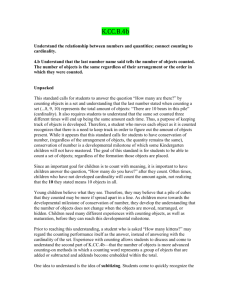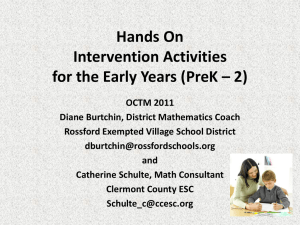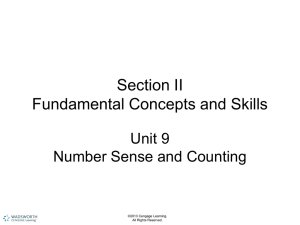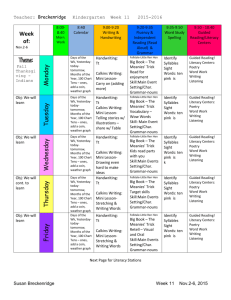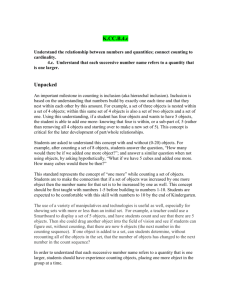Subitizing is attentional demanding - LEAD
advertisement
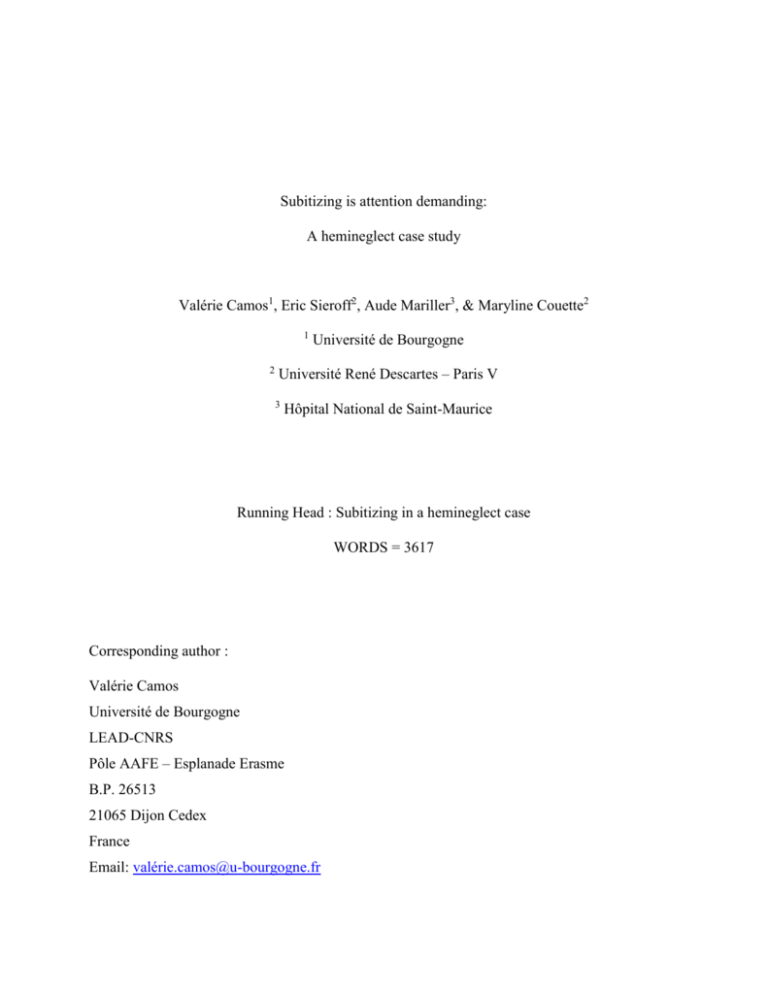
Subitizing is attention demanding: A hemineglect case study Valérie Camos1, Eric Sieroff2, Aude Mariller3, & Maryline Couette2 1 2 Université de Bourgogne Université René Descartes – Paris V 3 Hôpital National de Saint-Maurice Running Head : Subitizing in a hemineglect case WORDS = 3617 Corresponding author : Valérie Camos Université de Bourgogne LEAD-CNRS Pôle AAFE – Esplanade Erasme B.P. 26513 21065 Dijon Cedex France Email: valérie.camos@u-bourgogne.fr Subitizing is attention demanding: A hemineglect case study Abstract : In the literature, a debate persists concerning the exact nature of subitizing. The different models proposed to account for subitizing mainly differ in terms of whether or not attention is thought to be necessary for the processing of the objects to be enumerated. The present paper reports the performance of a left hemineglect patient who is unable to subitize dots in the contralesional left hemifield whereas the subitizing ability in the ipsilesional hemifield is preserved. Moreover, the addition of a distracter in the ipsilesional hemifield (i.e. extinction condition) impairs his subitizing performance in the neglected hemifield, whereas no change occurs in the preserved hemifield. These results support models, which assert that subitizing requires attention. Keywords: Subitizing, Attention, Hemineglect 1 1. Introduction Object enumeration is one of the first numerical skills thought to emerge from infants' protonumeric capacities. This skill has been extensively studied ever since the end of the nineteenth century, and a distinction has been made between two processes involved in enumeration (Jevons, 1871; Wundt, 1896). Indeed, during object enumeration, response times (RTs) do not increase linearly with the number of objects. Instead, the RTs remain relatively flat up to three or four objects whereas they increase linearly beyond this number. Similarly, when objects are presented only briefly, the error rate is extremely low for arrays up to three or four, and then increases linearly. It has thus been argued that subitizing is responsible for the former aspect of performance and counting for the latter (Chi and Klahr, 1975; Dehaene and Cohen, 1994; Kaufman, et al., 1949; Mandler and Shebo, 1982). Although subitizing is well documented, a debate persists concerning its exact nature. The various models proposed to account for subitizing differ in terms of the involvement of attention. On the one hand, some models, such as Trick and Pylyshyn’s (1993; 1994) FINSTs theory and Dehaene and Changeux’s (1993) accumulator model, assume that subitizing is primarily based on a preattentive process. According to the FINSTs theory, a limited number of fingers of instantiation (tags) are attributed to objects in a preattentive stage of the visual analysis of the display. The number of tags used gives the number of objects. For Dehaene and Changeux (1993), subitizing is based on a parallel estimation process which produces a sufficiently precise response for small numerosities. On the other hand, several models predict that attention has to be allocated in order to subitize objects. For example, Gallistel and Gelman (1991, 1992) suppose that subitizing is simply a fast nonverbal counting. Mandler and Shebo (1982), and Peterson and Simon (2000), assume that the number of presented objects is identified by means of pattern recognition. Although these authors account for subitizing in terms of different mechanisms, both 2 counting and recognition are attentional processes. This controversy is further exacerbated by the inconsistent results from brain imagery studies (Piazza et al., 2001, 2003; Sathian et al., 1999). The aim of the present study was to distinguish between these two classes of model. To this end, we tested the subitizing ability of a left hemineglect patient. Hemineglect syndrome is characterized by impairment in orienting attention and is frequently observed following a lesion in the right parietal lobe (Bartolomeo and Chokron, 2001; Mesulam, 1985). Patients experience difficulties in responding to stimuli occurring in the contralesional hemifield, and this difficulty is increased when a stimulus is simultaneously presented in the ipsilesional hemifield (extinction phenomenon: Bisiach, 1991; Driver and Vuilleumier, 2001). The rationale of the present study was to compare the enumeration performance obtained in each hemifield by a left hemineglect patient. First, if counting and subitizing are based on two distinct processes, whatever the attentional nature of these processes, then we would expect the classic curve to be observed in each hemifield Second, because counting is attentionally demanding even in adults (Camos and Barrouillet, in press), the patient's counting performance should be worse for the contralesional hemifield than for the ipsilesional hemifield. Third, if subitizing requires attention, the patient's performance should differ for the two hemifields, with lower performance for the left and a preserved ability for the right hemifield. This attentional hypothesis would be strengthened if subitizing performance is strongly affected by the presence of a distracter in the right hemifield (extinction). On the contrary, if subitizing is based on a preattentive process, the patient's subitizing ability should be preserved in both hemifields, and should not be affected by the extinction phenomenon. 2. Method 2.1. Patient 3 GD is a right-handed 63 year-old man with a left hemineglect resulting from a right fronto-parietal ischemic lesion. He also suffers from a left hemiparesis. The diagnosis of unilateral neglect was made a few weeks after the ictus, using the GEREN test (2002). We tested him 8 months later. Although we were not allowed to report detailed results from the clinical examination, they indicated that GD still suffered from a left hemineglect at the time of the study. 2.2 Material and procedure Before the experiment itself, the patient underwent a sight test that we designed ourselves. In both the sight test and the experiment, the stimuli were presented on an Apple Powerbook G3 computer using Psyscope software (Cohen et al., 1993). In the sight test, the stimuli were black dots of 1 cm diameter presented on a white screen. The dots were presented one at a time in two invisible 10 x 10 cm squares the closest side of which was situated 2 cm to the left or right of a fixation item. In consequence, the dots appeared at an angle of 2° to 12° for the patient, who was seated 60 cm from the screen. Within each square, the dots could appear in one of eleven different positions (Figure 1). Each position was tested 10 times. Thus, 220 trials (2 squares x 11 positions x 10 times) were randomly presented to the patient. Each trial began with a 1000 ms warning signal in the center of the screen (fixation item). Next, a single dot was displayed for 200 ms in each trial. The patient was asked to say whether or not he saw the dot. When ready, the patient clicked on the mouse. Four practice trials were presented prior to the test. The experiment was similar to the sight test: each trial began with a 1000 ms warning signal in the center of the screen, followed by an array of one to six dots presented for 200 ms. Black dots of 1 cm diameter appeared in one of the two squares. Ten different arrays were built for each size. The positions of the dots within the arrays were randomly chosen using a matrix. Half of the arrays were presented in the right hemifield, and the other half in the left hemifield. 4 Thus, the patient saw 120 trials (6 sizes x 10 arrays x 2 sides) in this unilateral condition. The 120 trials used in the extinction condition were identical, except that the contralateral square was made apparent by coloring it in gray (distracter). The presence of such a distracter should induce the extinction phenomenon. Indeed, it has recently been shown that when patients cannot predict the hemifield in which the stimuli will occur, as in the present study, the simple presence of a distracter is sufficient to elicit extinction (Sieroff and Urbanski, 2002). The experimental trials were presented in two sessions separated by a 2-hour break: the unilateral block preceded the extinction block in session 1, and the block order was reversed in session 2. The order of presentation of each trial was randomized. The patient’s task was to say aloud the number of dots, with a voice key stopping the timer. The patient clicked on the mouse to trigger the next trial. Twelve practice trials (3 trials x 2 sides x 2 conditions) were presented before each session. 3. Results The sight test showed that GD had a left inferior quadranopsia (Figure 1). Such a visual deficit can have an obvious impact on enumeration processes. As a consequence, before analyzing GD’s counting and subitizing performance, we determined the number of dots that GD could see in each trial (at over 70% visibility). This procedure resulted in a change in the overall number of trials analyzed for each size in the left hemifield. Fifteen trials with one dot (Size 1) in the non-damaged part of the left hemifield occurred in each condition. Similarly, Size 2 occurred 18 times, Size 3 11 times, Size 4 8 times, Size 5 2 times, and Size 6 never occurred. Because Size 6 only occurred in the right hemifield, this size was discarded from the analyses. We analyzed the number of incorrect responses including the no-responses, and the response times when GD did give an answer. In some trials (29 out of 208), GD did not respond. 5 An absence of response was found more frequently with left (7 and 21) than with right (1 and 0) hemifield stimuli, 2 (1) = 4.39, p < .05 and 2 (1) = 24.36, p < .0005 in unilateral and extinction conditions respectively. Moreover, because GD produced a large number of errors, it was not possible to perform response time analyses for correct responses. The results showed a significant difference in errors between the two hemifields with a higher error rate in the left hemifield (57 and 72%) than in the right hemifield (18 and 16%), 2 (1) = 17.03, p < .005 and 2 (1) = 33.13, p < .005, but no difference in response times, t (94) = 1.67, p = .10 and t < 1 in the unilateral and extinction conditions respectively (Figure 2). Before testing our specific hypotheses, we analyzed GD’s performance in the preserved field to ensure that he was able to subitize. In the right hemifield, GD presented the classic pattern of results in the unilateral condition. To determine GD’s subitizing range, we used successive planned comparisons contrasting 1 to n vs. n+1 to 5, in which the subitizing range was n at the point where the comparison became significant (Chi and Klahr, 1975). This analysis showed that 3 was the limit of his subitizing range, because the comparison 1 to 3 vs. 4 was the first to be significant both in terms of errors, F (1, 9) = 6.00, p = .037, and in terms of response times, F (1, 8) = 36.90, p < .001. It should be noted that his subitizing slope (14 msec) differed greatly from his counting slope (368 msec) as is usually found in enumeration studies. Furthermore, GD made no errors on the numerosities 1 to 3 whereas the error rate increased beyond this range (45%), 2 (1) = 16.46, p < .005. Similarly, the response times were lower for these small numerosities (584 msec) and increased for the larger ones (1345 msec), t (47) = 8.49, p < .0001. These latter results confirmed the fact that GD possessed a preserved subitizing ability on the right side. The analyses presented below tested our 4 predictions. First, although the error rate in subitizing (Sizes 1 to 3) and in counting (Sizes 4 and 5) did not differ in the left hemifield for 6 either condition (ps >.10), the response times were longer in counting (1443 and 1250 msec) than in subitizing (1027 and 897 msec), t (45) = 1.79, p = .090 and t (31) = 2.34, p = .036 in unilateral and extinction conditions respectively. Second, concerning GD’s counting performance (i.e. for Sizes 4 and 5), the error rate was greater in the left than in the right hemifield both in the unilateral (80% vs 45%), 2 (1) = 3.33, p < .10, and in the extinction condition (80% vs 40%), 2 (1) = 4.29, p < .005, although the times did not differ (ps > .16). These results showed that his performance in an attentionally demanding activity such as counting were worse when the objects were presented in the neglect field. Third, as predicted by the hypothesis that subitizing is attentionally demanding, GD’s error rate in the subitizing range (from 1 to 3) was significantly greater in the left (52 and 71%) than in the right hemifield (0 and 0%), 2 (1) = 22.75, p < .0001 and 2 (1) = 36.37, p < .0001 in unilateral and extinction conditions respectively. A similar effect was observed for response times (left: 1027 and 897 msec vs right: 584 and 563 msec), t (66) = 3.11, p = .004 and t (54) = 3.31, p = .002 in unilateral and extinction conditions respectively. Finally, the hypothesis that subitizing requires the allocation of attention was strengthened by the observed effect of the conditions in the left hemifield. Indeed, in this hemifield, GD made more errors in subitizing when a distracter was presented in the ipsilesional hemifield (71%) than when it was not (52%), 2 (1) = 3.07, p < .10, without this causing any difference in RTs, p = .43. It should also be noted that the extinction condition provoked significantly more no-responses for left hemifield stimuli than the unilateral condition (41% vs14%), 2 (1) = 8.25, p < .005, whereas no significant change occurred in the error rate (0% for both conditions), response times (p =.72) or the number of no-responses (0 and 1) for right hemifield stimuli. 4. Discussion 7 This study investigated the subitizing ability of a hemineglect patient. GD exhibited typical performance in enumerating objects when these were presented in the ipsilesional hemifield. His counting and subitizing slope were very similar to what is classically observed in adults who do not suffer from brain damage (Mandler and Shebo, 1982; Sliwinski, 1997; Trick and Pylyshyn, 1993; Tuholski et al., 2001). Although GD made more errors in counting than would normally be expected for an adult of this age (Sliwinski, 1997; Trick et al., 1996), his overall performance in the right hemifield reflected the distinction between the two processes, counting and subitizing. Similarly, in the left hemifield, this distinction was still apparent, with counting taking longer than subitizing, although the number of errors was equivalent. These results reinforce models, which account for the discontinuities in enumeration performance in terms of the implementation of two distinct processes (Anderson, 1993; Dehaene and Cohen, 1994; Dehaene and Changeux, 1993; Mandler and Shebo, 1982; Peterson and Simon, 2000; Trick and Pylyshyn, 1994). As expected in a deficit in the orienting of attention like hemineglect, GD’s counting was worse in the contralesional hemifield than in the ipsilesional hemifield. In line with the hypothesis that the subitizing process is attention demanding, GD’s subitizing performance was poorer in the neglected than in the preserved hemifield. The direct comparison of the two hemifields in the same individual allows us to discard any interpretation in terms of a deficit in the retrieval of the number-words, given GD’s total success in subitizing objects in the ipsilesional hemifield. Nevertheless, it could be argued that the decrease in subitizing performance observed in the contralesional field is due to a visual deficit that hampers the preattentive analysis of the displays which, according to the FINSTs theory, is the major mechanism in subitizing. However, two arguments weaken this interpretation. First, the sight test ensured that the dots were presented in locations where they can be detected. Second, GD's 8 performance was similar to that of hemineglect patients with an intact visual field who were observed by Vuilleumier and Rafal (1999; 2000). Indeed, these patients exhibited a higher error rate in the left than in the right hemifield for subitizing 1 (6-22% vs. 0-3%) and 2 (28-38% vs. 03%) objects. GD exhibited an even higher error rate in the left hemifield (1: 33% and 2: 67%), most probably because the dots appeared in different positions on each trial in the present study, whereas they always appeared in the same position in Vuilleumier and Rafal’s study (1999; 2000). Thus, an interpretation in terms of a lack of attention seems to provide a more convincing account of the fall-off in subitizing performance in GD’s contralesional hemifield. Another argument in favor of this interpretation comes from the comparison between the extinction and the unilateral conditions. The presence of a distracter in the ipsilesional hemifield decreased subitizing performance in the contralesional hemifield. In the literature on hemineglect, this kind of effect is considered to be an overwhelming argument testifying to the involvement of attention (Bisiach, 1991; Vuilleumier and Rafal, 2000). Thus, although we could not determine the exact nature of the process (i.e., it could be based on a pattern recognition or another mechanism), the present study provides some evidence that the mechanism underlying subitizing requires the allocation of attention. References ANDERSON JR. Rules of the mind. Hillsdale : Erlbaum, 1993. BARTOLOMEO P and CHOKRON S. Levels of impairment in unilateral neglect. In Boller F and Grafman J (Eds) Handbook of neuropsychology, Vol. 4 . Amsterdam: Elsevier Science Publishers, 2001, pp. 67-98. 9 BISIACH E. Extinction and neglect: same or different? In Paillard J (Ed) Brain and space. Oxford: Oxford University Press, 1991, pp. 251-257. CAMOS V and BARROUILLET P. Adults counting is resource demanding. British Journal of Psychology., in press. CHI MTH and KLAHR D. Span and rate of apprehension in children and adults. Journal of Experimental Child Psychology, 19: 434-439, 1975. COHEN JD, MACWHINNEY B, FLATT M, and PROVOST J. Psyscope: A new graphic interactive environment for designing psychology experiments. Behavior Research Methods, Instruments, & Computers, 25: 257-271, 1993. DEHAENE S and COHEN L. Dissociable mechanisms of subitizing and counting: Neuropsychological evidence from simultanagnosic patients. Journal of Experimental Psychology: Human Perception and Performance, 20: 958-975, 1994. DEHAENE S and CHANGEUX JP. Development of elementary numerical abilities: A neuronal model. Journal of Cognitive Neuroscience, 5: 390-407, 1993. DRIVER J and VUILLEUMIER P. Perceptual awareness and its loss in unilateral neglect and extinction. Cognition, 79: 39-88, 2000. GALLISTEL CR and GELMAN R. Subitizing: The preverbal counting process. In Kessen W, Ortony A and Craik F (Eds) Memories, thoughts, and emotions: Essays in honor of George Mandler. Hillsdale: Erlbaum, 1991, pp. 65-81. GALLISTEL CR and GELMAN R. Preverbal and verbal counting and computation. Cognition, 44: 43-74, 1992. GEREN / French collaborative study group on assessment of unilateral neglect. Sensitivity of clinical and behavioural tests of spatial neglect after right hemisphere stroke. Journal of Neurology, Neurosurgery, and Psychiatry, 73: 160-166, 2002. 10 JEVONS WS. The power of numerical discrimination. Nature, 3: 281-282, 1871. KAUFMAN EL, LORD MW, REESE TW, and VOLKMANN J. The discrimination of visual number. American Journal of Psychology, 62: 498-525, 1949. MANDLER G and SHEBO BJ. Subitizing: An analysis of its component processes. Journal of Experimental Psychology: General, 111: 1-22, 1982. MESULAM MM. Attention, confusional states and neglect. In Mesulam MM (Ed) Principles of behavioral neurology. Philadelphia: Davis, 1985, pp. 125-168. PIAZZA M, GIACOMINI E, LE BIHAN D, and DEHAENE S. Single-trial classification of parallel preattentive and serial attentive processes using fMRI, submitted, Proceeding of the Royal Society Biological Sciences, 270: 1237-1245, 2003. PIAZZA M, MECHELLI A, BUTTERWORTH B, and PRICE CJ. Are subitizing and counting implemented as separate or functionally overlapping processes? NeuroImage, 15: 435-446, 2001. PETERSON SA and SIMON TJ. Computational evidence for the subitizing phenomenon as an emergent property of the human cognitive architecture. Cognitive Science, 24: 93-122, 2000. SATHIAN K, SIMON TJ, PETERSON S, PATEL GA, HOFFMAN JM, and GRAFTON ST. Neural evidence linking visual object enumeration and attention. Journal of Cognitive Neuroscience, 11: 36-51, 1999. SIEROFF E and URBANSKI M. Conditions of visual verbal extinction: Does the ipsilesional stimulus have to be identified? Brain and Cognition, 48: 563-569, 2002. SLIWINSKI M. Aging and counting speed: Evidence for process-specific slowing, Psychology and Aging, 12: 38-49, 1997. 11 TRICK LM, ENNS JT, and BRODEUR DA. Life span changes in visual enumeration: The number discrimination task. Developmental Psychology, 32: 925-932, 1996. TRICK LM and PYLYSHYN ZW. What enumeration studies can show us about spatial attention: Evidence for limited capacity preattentive processing. Journal of Experimental Psychology: Human Perception and Performance, 19: 331-351, 1993. TRICK LM and PYLYSHYN ZW. Why are small and large numbers enumerated differently? A limited capacity preattentive stage in vision. Psychological Review, 101: 80-102, 1994. TUHOLSKI SW, ENGLE RW, and BAYLIS GC. Individual differences in working memory capacity and enumeration. Memory and Cognition, 29: 484-492, 2001. VUILLEUMIER PO and RAFAL RD. “Both” means more than ‘two”: localizing and counting in patients with visuospatial neglect. Nature Neuroscience, 2: 783-784, 1999. VUILLEUMIER PO and RAFAL RD. A systematic study of visual extinction: Between- and within-filed deficits of attention in hemispace neglect. Brain, 123: 163-1279, 2000. WUNDT W. Grundriss der psychologie. Leipzig: Engelmann, 1896. 12 Acknowledgments We would like to thank GD for his kind participation, as well as Professors Bussel and Azouvi, Mrs Agard, and the Service de Rééducation Neurologique at Hôpital Raymond-Poincaré for their help. Finally, we are grateful to Patrik Vuilleumier for providing us the results of his patients. Figure Captions Figure 1 The 11 different positions used in each square to test the vision and the associate percentage of correct detection by G.D. when dots were presented in the left side. The line delimited the visually damaged part in the left side. Figure 2 Mean percentages of errors (bars) and mean response times in ms (lines) as a function of the side, the size of the arrays, and the conditions. 13 Figure 1 90 80 90 90 10 0 80 50 70 10 90 14 Figure 2 100 2100 unilateral extin ctio n unilateral extin ctio n 90 1800 80 Percenta ge of errors 60 1200 50 900 40 30 Response times 1500 70 600 20 300 10 0 0 1 2 3 left 4 5 1 2 3 4 5 right 15
